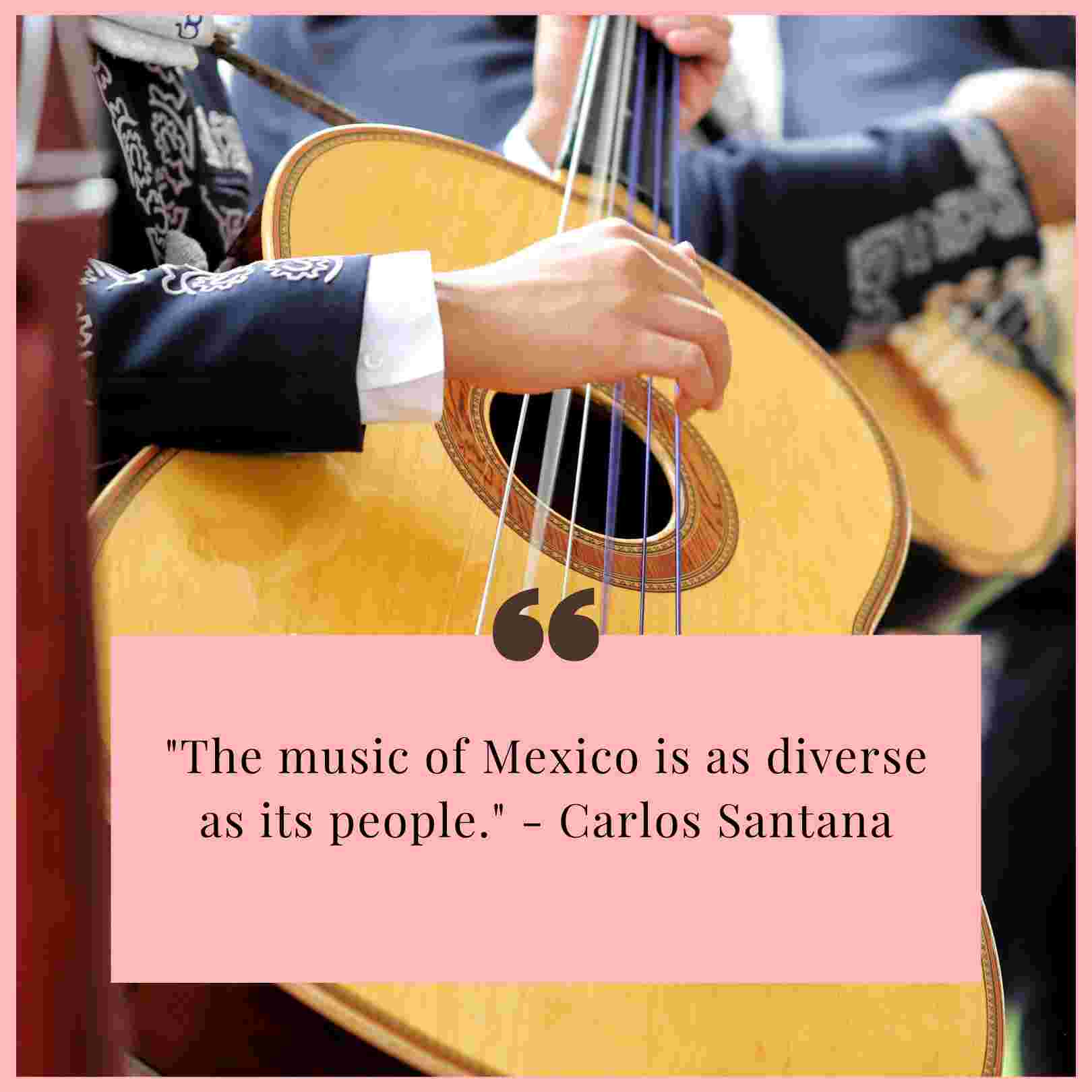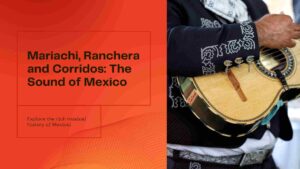
Mexican Music & All Time Greatest Musicians
Let’s dive into the symphony of Mexican Music & Greatest Musicians – a rich blend echoing ancient civilizations, colonial echoes, and rhythms that transcend borders. Mexican music isn’t just beats; it’s a cultural legacy that’s played on a global stage, shaping sounds worldwide.
Musical Roots Run Deep
Picture this: ancient Aztec drums meeting Spanish guitars. That’s Mexican music, a fusion of indigenous vibes and colonial echoes. It’s a journey through time, with melodies that tell tales of civilizations long gone.
Mexico’s Musical Thunder Across the Globe
Ever wondered why your favorite pop or rock song has a hint of Mexican flair? It’s not a coincidence. Mexican music, from the soulful rancheras to the lively mariachi, has a passport stamped with global influence. Icons like Rodrigo y Gabriela are the ambassadors of this musical fiesta.
Beats as Diverse as Mexico’s Landscape
Close your eyes and you’ll hear it, the rhythmic heartbeat of Mexico’s diverse musical landscape. From the foot-tapping energy of mariachi to the storytelling magic of corridos, it’s a sonic journey through Mexican culture. Each genre is a color in the vibrant palette of Mexican music.
Traditional Mexican Music: Mariachi, Ranchera and Corridos
Mariachi
Picture this: the heart of Mexico’s musical soul, the Mariachi. It started as a humble tune echoing through rustic landscapes, evolving into a cultural powerhouse. Trumpets blaring, violins weeping, guitars strumming Mariachi is a vibrant dance of sounds.
These iconic instruments are the Mariachi maestros trumpet, violin and guitar. Dressed to impress in wide-brimmed hats and embroidered flair, Mariachi isn’t just a sound, it’s a visual fiesta.
But here’s the twist: Mariachi isn’t confined to tradition. It’s the cool kid collaborating with pop and rock, turning tradition into a global rhythm. It’s not just music, it’s the beating heart of a dynamic Mexican melody.
Ranchera
Meet Ranchera, the musical storyteller of rural Mexico. It’s more than a genre, it’s a folk tale sung. Love, revolution, folklore it’s Ranchera’s narrative, woven into the fabric of Mexican life.
These songs aren’t just notes, they’re emotional time capsules. They tell tales of struggle and triumph, creating an anthem for the soul of Mexico.
Legends like Vicente Fernandez and Chavela Vargas aren’t just singers, they’re Ranchera royalty. Their voices carry the weight of history, turning Ranchera into an international legend, a Mexican masterpiece.
Corridos
Enter Corridos, the musical historian of Mexico. Think of it as a ballad, a lyrical documentary of the country’s highs and lows. Justice, resistance, societal battles it’s Corridos, the voice of the people.
From historical sagas to modern-day commentary, Corridos evolve with the times. They’re not just tunes, they’re mirrors reflecting Mexican society’s struggles and triumphs.
In today’s world, Corridors aren’t silent. They’re the bold voice tackling today’s issues. They’re not just songs, they’re a conversation, a lyrical commentary on the ever-changing rhythm of Mexican life.
Contemporary Mexican Music
Latin Alternative
- A Musical Revolution Unleashed
Late ’90s, the birth of Latin Alternative shook things up. Imagine a musical rebellion, smashing through borders and creating a vibe that’s anything but ordinary.
- Rebel Artists Redefining Rules
Picture this: Rodrigo y Gabriela, rebels with a cause. They ditched the norm, blending rock, hip-hop and electronica. They’re not just artists, they’re rule-breakers rewriting the melody of Mexican music.
- World Groove: Rodrigo y Gabriela’s Global Riff
Fast forward to today. Rodrigo y Gabriela’s tunes aren’t just echoing through Mexico. They’re hitting global charts, creating a new Latin identity in the world’s music heartbeat.
Mexican Ska
- Ska’s Time Travel: Back to the ’60s
Picture the ’60s, Mexican bands grooving to Jamaican ska beats. That’s the birth of Mexican Ska, a journey through time and sound.
- Ska’s Punk Party: ’80s Revival
Jump to the ’80s, punk crashes the Ska party. The result? A genre resurgence, a vibrant mashup that kept Ska alive, kicking and pulsating.
- Ska Icons: Panteón Rococó & La Maldita Vecindad
Panteón Rococó and La Maldita Vecindad – imagine them as the Ska superheroes. Their music not only shaped the scene but turned Ska into a cultural force to be reckoned with.
Electronic in Mexican Music
- Beats Beyond Boundaries: Electronic Pioneers
Think of electronic music as a canvas. Murcof and Nortec Collective are the artists, painting a masterpiece that merges tradition with innovation.
- Tradition Meets Tech: Murcof & Nortec Collective
Close your eyes, you hear ancient rhythms colliding with electronic wizardry. That’s the magic Murcof and Nortec Collective bring, a fusion that’s both timeless and cutting-edge.
- Sonic Revolutionaries: 3Ball MTY & Mexican Institute of Sound
3Ball MTY and Mexican Institute of Sound – they’re not just making beats, they’re crafting a Mexican electronic revolution. Feel the pulse, it’s not just local, it’s global.

Other Latin Beats extend from Cuba to the Heart of Mexico
Rhythmic Odyssey includes Rumba, Mambo, Cha Cha Chá, Danzón and Bolero
- Groovy Origins
- Picture this: Imagine the beats of Rumba, Mambo, Cha Cha Chá, Danzón and Bolero as threads woven into the vibrant tapestry of Mexican culture.
- Dance Through History: These rhythms aren’t just music, they’re historical footprints, telling stories of joy, love and Mexican resilience.
- Cuban Vibes in Mexico
- Musical Tinder: Picture Cuban melodies swiping right on Mexican hearts, leading to a harmonious affair.
- Mixing It Up: Cuban beats and Mexican soul – a musical cocktail that birthed a symphony of uniquely Mexican styles.
- Mexican Fusion Groove
- Innovation Nation: Rumba, Mambo, Cha Cha Chá, Danzón and Bolero didn’t just cross borders, they morphed into something uniquely Mexican.
- Rhythmic Alchemy: Local artists turned these borrowed beats into a homegrown fusion, giving Mexico its signature musical swagger.
Bolero is both a Cuban gift and a Mexican love affair
- Cuban Bolero’s Road Trip
- Love Across Borders: Cuban Bolero packed its bags and headed to Mexico, a journey laden with cultural exchange.
- Mexican Serenade: Agustín Lara and Consuelo Velázquez fell in love with the Cuban serenade, creating a Mexican Bolero love story.
- Bolero’s Golden Maestros
- Golden Age Extravaganza: Enter the golden age of Bolero in Mexico, where musical maestros like María Grever and Gonzalo Curiel Barba ruled the scene.
- Legacy Echoes: Their timeless tunes still resonate, echoing through the annals of Mexican musical history.
- Bolero in the Now
- Luis Miguel’s Bolero Symphony: Picture Luis Miguel, the modern-day Bolero maestro, seamlessly blending the classic with the contemporary.
- Reinventing Romance: Bolero isn’t a relic, it’s a living, breathing genre in today’s Mexican music scene.
Romantic Ballads are Love Notes from Latin America
- Ballad Evolution: From Bolero to Heartfelt Tunes
- Musical Evolution Tale: Imagine the Latin American Bolero evolving into the heartstring-tugging Romantic Ballad, a ballad for every romantic soul.
- Changing Beats: It’s not just a change in tempo, it’s a cultural shift, a musical metamorphosis.
- Pioneers of Passion: José José and Luis Miguel
- Ballad Mavericks: Meet José José and Luis Miguel, the trailblazers turning heartbreaks into melodies.
- Musical Influence: Their magic didn’t just change the music scene, it shaped the emotions of a generation.
- Global Serenade: Mexican Ballads Conquer the World
- International Love Affair: Feel the global heartbeat syncing with Mexican Romantic Ballads, winning awards and hearts worldwide.
- Musical Ambassadors: These ballads aren’t just songs, they’re Mexico’s cultural ambassadors, spreading love and melody across borders.
Let the rhythms of Rumba, Bolero and Romantic Ballads carry you into a world where each beat is a heartbeat, each melody a love story. This is Mexican music – a symphony of passion and rhythm.
Tropical and Cumbia form a rhythmic journey in Mexican music
Tropical Music
Tropical music in Mexico boasts a rich history, spanning over six decades and becoming an integral part of the country’s musical identity. The genre is characterized by vibrant rhythms, lively orchestrations and a fusion of diverse musical elements.
Historical Evolution
Tropical orchestras, with their infectious beats, emerged in the mid-20th century, captivating audiences with their energetic performances. Rooted in Afro-Caribbean traditions, these orchestras became synonymous with celebration, dance and the tropical spirit.
Cuban Influence
Cuban musical influences played a pivotal role in shaping Mexican tropical music. A shining example of this influence is evident in the success of Los Hermanos Rigual, a Cuban vocal group based in Mexico during the 1960s. Their breakout hit, “Cuando calienta el sol,” not only conquered Mexican charts but also left an indelible mark on the global music scene.
Global Impact
One of the torchbearers of Mexican tropical music on the international stage is the iconic Sonora Santanera. With a musical journey spanning over 60 years, this orchestra has become a cultural ambassador, showcasing the vibrant sounds of Mexico to audiences worldwide. Their fusion of traditional tropical rhythms with modern elements continues to resonate globally, making them a symbol of Mexican musical excellence.
Cumbia
Cumbia, with its infectious rhythm and dance-inducing beats, has deep roots in Mexican musical heritage, tracing back to the 1940s. This genre has undergone a fascinating evolution, giving rise to diverse styles like Cumbia sonidera and Tecno-cumbia.
Historical Significance
The history of Cumbia in Mexico is intertwined with the arrival of Colombian singers in the 1940s. Collaborating with Mexican orchestra director Rafael de Paz, they recorded what many consider to be the first cumbia recorded outside of Colombia, titled “La Cumbia Cienaguera.” This marked the beginning of Cumbia’s popularity in Mexico.
Fusion and Variation
As Cumbia gained popularity, it underwent various transformations, leading to the emergence of distinctive styles like Cumbia sonidera and Tecno-cumbia. These variations incorporate elements of electronic music, reflecting the dynamism and adaptability of Mexican musical traditions.
Maestros of Mexican Cumbia
Prominent figures in Mexican Cumbia, such as Rigo Tovar and Celso Piña, have left an indelible mark on the genre. Rigo Tovar, known for his fusion of Cumbia with ballad and rock, became a musical pioneer in the 1970s. Celso Piña, on the other hand, earned the title of “Rebel of the Accordion,” pushing the boundaries of traditional Cumbia with innovative fusions.
Art Music includes operas and works by classical composers
Operas
Mexico’s operatic legacy dates back to its early compositions, notably highlighted by Manuel de Zumaya’s opera “La Parténope,” premiered in the 18th century. This marked the inception of Mexican opera, blending European operatic influences with indigenous elements. The fusion of these diverse cultural elements sculpted the distinct character of Mexican opera, characterized by its unique storytelling and musical aesthetics.
Renowned Mexican opera singers have played pivotal roles in showcasing the country’s talent on the international stage. Ángela Peralta, often hailed as “The Mexican Nightingale,” earned widespread acclaim and recognition globally for her remarkable performances, contributing significantly to the elevation of Mexican opera in the world of classical music.
Classical Music
Classical music in Mexico boasts a rich heritage tracing back to the 16th century, marked by the compositions of notable maestros like Juan Gutiérrez de Padilla. These early composers laid the foundation for a tradition that amalgamated European influences with indigenous sounds, creating a distinct Mexican classical music style.
The contributions of revered classical composers like Manuel M. Ponce and Silvestre Revueltas have been integral to the evolution of Mexican classical music. Ponce, celebrated for his compositions for the Spanish classical guitar, expanded the repertoire of this instrument, merging Native American and European musical elements into an innovative and original style. Meanwhile, Revueltas’s works, such as “The Night of the Mayas” and “Sensemayá,” showcased a fusion of traditional Mexican music with avant-garde orchestral arrangements, earning global recognition.
In contemporary times, the legacy of Mexican classical music continues to thrive through the compositions of artists like Arturo Márquez. Márquez’s compositions resonate with a blend of tradition and modernity, enriching the classical music landscape and ensuring the enduring heritage of Mexican music reaches new heights.
By nurturing its operatic heritage and fostering innovation in classical compositions, Mexico’s musical tapestry remains an essential part of the global classical music landscape, reflecting a vibrant cultural identity rooted in tradition and innovation.
Jazz in Mexico
Jazz in Mexico has transcended boundaries, producing exceptional musicians who’ve made a lasting impact on the global jazz scene. Here, we explore the noteworthy contributions of Magos Herrera, Tino Contreras and Antonio Sánchez, highlighting Mexico’s vibrant jazz culture.
Notable Mexican Jazz Musicians
- Magos Herrera: A Fusion of Traditions
Magos Herrera, the renowned Mexican jazz vocalist, seamlessly blends traditional Mexican music with contemporary jazz. Her soulful interpretations and cross-cultural dialogues have not only elevated Mexican jazz but have also resonated with audiences worldwide.
- Tino Contreras: Pioneering Rhythms
Tino Contreras, a pioneering jazz drummer, has significantly shaped the Mexican jazz landscape. His innovative drumming techniques and collaborations with global jazz icons have propelled him to international acclaim, contributing to the evolution of Latin jazz.
Recognition and Influence on Global Jazz
- Antonio Sánchez: Rhythmic Virtuosity
Antonio Sánchez, the acclaimed jazz drummer and composer, stands out for his rhythmic virtuosity. Collaborating with international jazz giants like Pat Metheny and Chick Corea, Sánchez has pushed the boundaries of jazz composition, leaving an indelible mark on the global stage.
C. Jazz Festivals and the Jazz Community in Mexico
- Fostering Diversity in Jazz
Mexico hosts a spectrum of jazz festivals, including the Riviera Maya Jazz Festival and the Guadalajara Jazz Festival, attracting global talent. These events showcase the diversity of the Mexican jazz scene, providing a platform for both local and international artists.
- Thriving Jazz Community
Mexico’s jazz community is characterized by its diversity, encompassing musicians, enthusiasts and dedicated venues. Local jazz clubs and educational initiatives contribute to nurturing new talent, ensuring the sustainability of a dynamic jazz culture.
Greatest Mexican Musicians
Legends of Mexican Music
Vicente Fernandez
- A towering figure in traditional Mexican music, Vicente Fernandez, known as “El Rey de la Música Ranchera” (The King of Ranchera Music), has left an indelible mark on the genre.
- With his rich baritone voice and iconic charro persona, Fernandez’s career spans decades, earning him multiple Grammy Awards and the adoration of fans globally.
- His emotionally charged performances in Ranchera and Mariachi genres resonate with themes of love, heartbreak and the Mexican experience.
Chavela Vargas
- Renowned for her raw, passionate interpretations of Ranchera and Bolero, Chavela Vargas defied traditional gender roles and became a trailblazer in Mexican music.
- Her androgynous style and soul-stirring voice brought a new dimension to traditional Mexican compositions, challenging societal norms.
- A close friend of iconic artist Frida Kahlo, Vargas’s influence extends beyond music, making her a symbol of artistic expression and authenticity.
Revolutionary Figures in Contemporary Genres
Rodrigo y Gabriela
- Pioneers of the Latin alternative movement, Rodrigo y Gabriela, the acoustic guitar duo, seamlessly blend flamenco, rock and world music influences.
- Their unique sound has garnered international acclaim, with albums like “11:11” and “Mettavolution” showcasing their virtuosity and genre-defying approach.
- Rodrigo y Gabriela’s influence extends beyond borders, embodying the spirit of innovation in contemporary Mexican music.
Café Tacuba
- At the forefront of the Rock en Español movement, Café Tacuba has consistently pushed artistic boundaries, fusing rock, punk, electronic and traditional Mexican sounds.
- Their self-titled album, “Café Tacuba,” is a landmark in the Latin alternative genre, earning them Grammy Awards and a dedicated global fanbase.
- Known for their eclectic style and thought-provoking lyrics, Café Tacuba has become a symbol of Mexico’s vibrant musical experimentation.
Cross-Genre Musicians with Enduring Legacies
Luis Miguel
- “El Sol de México” (The Sun of Mexico), Luis Miguel is a pop and bolero icon, recognized for his unparalleled vocal talent and charismatic stage presence.
- With hit albums like “Romance” and “Segundo Romance,” Luis Miguel has not only dominated the Latin music scene but has achieved international success.
- His contributions to Mexican music include a seamless blend of bolero, pop and ballad, earning him accolades such as Grammy and Latin Grammy Awards.
Arturo Márquez
- A contemporary classical composer, Arturo Márquez is celebrated for his contributions to orchestral music with a distinct Mexican flair.
- Compositions like “Huapango” exemplify the essence of contemporary Mexican classical music, fusing traditional folk dance elements with innovative orchestral arrangements.
- Márquez’s work extends beyond classical circles, reaching diverse audiences and showcasing the richness of Mexican musical heritage.
Conclusion:
Mexican music, with its roots deeply embedded in the diverse cultural history of the nation, has left an indelible mark on the global musical landscape. From the timeless tales of love and loss in Ranchera to the rhythmic beats of Cumbia, the impact of Mexican music extends far beyond borders. Icons like Vicente Fernandez and trailblazers like Café Tacuba not only define genres but serve as cultural ambassadors, carrying the soul of Mexico to international audiences.
Reflecting on its enduring impact reveals a musical legacy characterized by authenticity and innovation. The call for appreciation and exploration encourages enthusiasts to uncover the vast spectrum of Mexican musical treasures, embracing both traditional and contemporary expressions. As Mexican music evolves dynamically in the global landscape, marked by collaborations and diverse influences, it continues to contribute vibrantly to the ever-expanding tapestry of global musical diversity.
Let the celebration of Mexican music be a harmonious journey through its glorious past and a spirited embrace of its promising future.
- Mar 20, 2024
Native Mexican Animals: Fascinating Wildlife
Fascinating Wildlife of Mexico: Native Mexican AnimalsWelcome to the top notch international of Mexico's natural world! Mexico is a place
- Mar 14, 2024
Safeway Money Order: Best Locations
Find out how easy and safe it's miles to ship cash with Safeway Money Orders. This manual suggests where to
- Mar 08, 2024
The Stock Market Plumbing To
In the complicated world of investing, the stock market plumbing sounds like a strange term. But it is an apt
- Feb 24, 2024
Beyond Finance Legit: Navigating with
Beyond Finance Legit: Unraveling the Legitimacy of Financial Service Providers in Today's Complex Landscape In modern-day complicated monetary panorama, it
- Feb 21, 2024
The Fundamentals of Corporate Finance
Unveiling the Core Tenets: Exploring 'The Fundamentals of Corporate Finance' When we talk about the fundamentals of corporate finance, we're






Carolyn Higgins
February 4, 2024Hello! I’ve been following your site for some
time now and finally got the bravery to go ahead and give you a shout out from Lubbock Texas!
Just wanted to say keep up the great job!